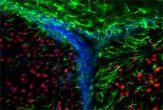
Deterioration of body and mind are the prices our bodies pay for protection against cancer as we grow older, new studies suggest.
Scientists have discovered that a gene involved in tumor suppression also plays an important role in determining when certain cells in the body cease multiplying and start deteriorating. As cells age, the gene, called p16INK4a, becomes more active. The cells have greater protection against cancer but lose the ability to divide. Cells that don't divide die off and are not replaced.
The studies, detailed together in the Sept. 7 issue of the journal Nature, suggest the physical and mental ravages that accompany aging are not the result of simple wear and tear of the body, but of a cellular decline that is programmed into our genes—one designed to safeguard us against copying mistakes that become more frequent as we grow older.
"This research tells us why our old tissues have less regenerative capacity than young tissues," said Sean Morrison of the University of Michigan, who was involved in one of the studies. "It's not that old tissues wear out—they're actively shutting themselves down, probably to avoid turning into cancer cells."
No free lunch
Research teams from three medical schools examined the role of p16INK4a in cells collected from different parts of the body in mice.
One team, from the University of North Carolina (UNC) at Chapel Hill, looked at the gene's role in pancreatic islet cells, which produce and secrete the hormone insulin and which are defective in persons with Type 1 diabetes. Another team from the University of Michigan examined brain stem cells, while a third, from Harvard University, looked at p16INK4a in blood stem cells.
Sign up for the Live Science daily newsletter now
Get the world’s most fascinating discoveries delivered straight to your inbox.
All three studies found similar results: as animals got older, p16INK4a activity increased and the cells eventually stopped dividing. Cells in mice deficient in the gene continued to divide but were more likely to turn cancerous, while cells in animals with over-expression of the gene stopped dividing earlier and aged prematurely.
The experiments also showed that cells taken from old animals remember their "age" and continue to deteriorate at their previous rate even when transplanted into young animals.
This last finding raises new questions about the usefulness of adult stem cells in tissue and organ repair compared to embryonic stem cells.
Fresh debate
The use of embryonic stem cells in medical research is currently a topic of fierce debate because harvesting the cells destroys developing embryos. As an alternative, some scientists are trying to use stem cells taken from adults and grow them into tissues in the lab; the new cells could then be reintroduced into the patient's body to replace failing tissues or organs.
"I think this data undermines that notion," said Norman Sharpless, a researcher at the University of North Carolina (UNC) at Chapel Hill who was involved in all three studies. "It shows that even these [adult] stem cells, which have the properties of self-renewal, are not limitless in their capacity to regenerate themselves. There are tumor-suppression mechanisms that limit their longevity."
Not all of the researchers agree. Morrison, the University of Michigan researcher, doesn't think the findings will have a drastic impact on how doctors use stem cells.
"I don't think this is a reason to say that embryonic stem cells are more valuable that adult stem cells," he said in a telephone interview. "It's been recognized for a long time that young adult [stem] cells are more robust than old ones. For example doctors are reluctant to do bone marrow transplants when the donor is old."
The more important consequence of the new findings, Morrison said, is that it helps explain embryonic stem cells' seemingly limitless ability to divide and become new cells.
These tumor-suppression "mechanisms probably don't exist in embryonic stem cells, and that's why they can proliferate indefinitely, while adult stem cells can't," he said.
Potential uses
The findings could prove to have numerous practical uses as well, the researchers say. For example, p16INK4a could be used as a "biomarker" to determine a cell's age. It is "like an odometer almost—you can use it to tell the mileage of the tissue," Sharpless told LiveScience.
This could allow doctors to one day do things like sort blood stem cells based on physiological age to determine whether someone will be a good bone marrow donor or not.
Also, it might be possible to create drugs that temporarily inactivate p16INK4a and promote healing in damaged cells, Morrison said.
"We could give people who have injuries a drug like that for a week or two weeks or a month," he said. "That's not likely to cause cancer, and even if some cells started to divide a little out of control during that period, you just stop the drug and p16INK4a comes back on and shuts things down again."
The findings might also lead to new kinds of therapies aimed at slowing or reversing the effects of aging, the researchers say. In the experiments, shutting down p16INK4a activity relieved only some, but not all, of the negative repercussions of aging. But scientists know of other tumor suppressor genes, and manipulating many of them at once might have a greater effect, Morrison said.
"Maybe if we look at the aggregate effects of five or six different tumor suppressors, we might be able to rescue most of the aging effect," he said.
